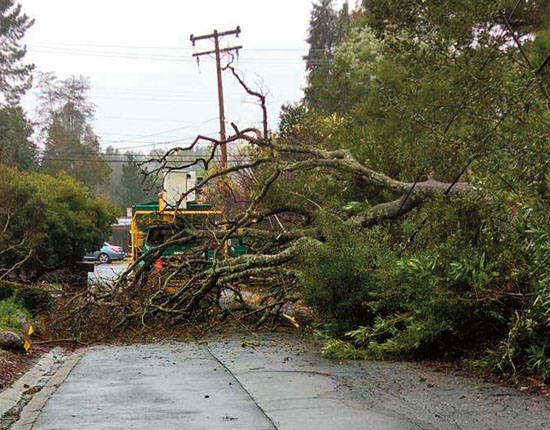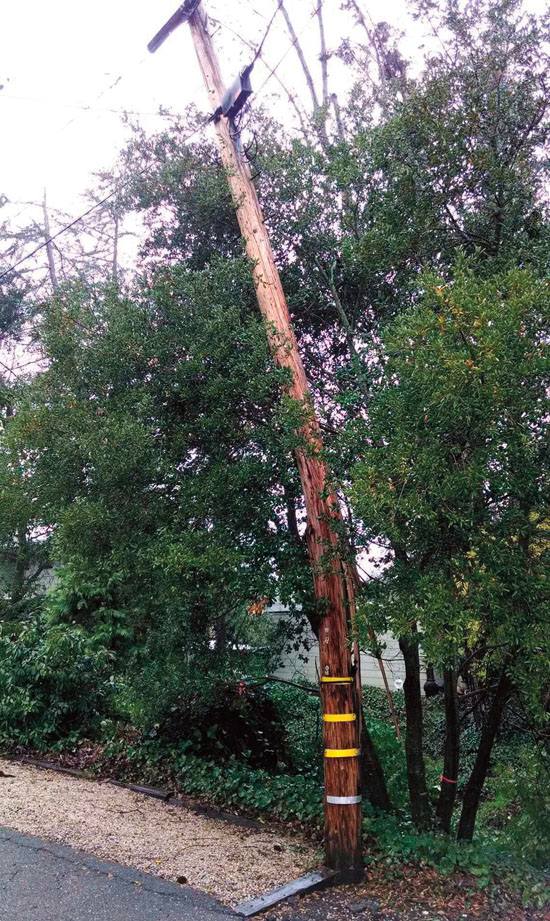 | | | A downed tree on Rancho Road in Lafayette is removed. Photo Dana Farkas | | | | | | Local trees, including mature oaks and pines, are falling and in need of removal, but the recent El Nino rain storms are only partly to blame. It is more apt to be a combination of events - call it the perfect storm - causing their demise. Recent Lamorinda examples reported by Nixle, a government emergency notification system, include downed power lines on LaCintella in Orinda and along Orchard Road due to collapsed trees, a road closure in Canyon due to a fallen tree on Pinehurst, and Miner Road closed near Camino Pablo because of a downed tree.
 The World Meteorological Organization called the years 2011-2015 the warmest five-year period on record, and "trees suffered during the drought," said Jim Turner of Bruce Maciver Company. Turner should know - he's made his living climbing trees for 34 years, the last 28 working for Maciver.
The World Meteorological Organization called the years 2011-2015 the warmest five-year period on record, and "trees suffered during the drought," said Jim Turner of Bruce Maciver Company. Turner should know - he's made his living climbing trees for 34 years, the last 28 working for Maciver.
 Combine heavy winds with rain saturated ground and affected trees can easily be blown over, he said. "Pines and eucalyptus are evergreens; they just get so wet and heavy," they end up falling over, Turner said.
Combine heavy winds with rain saturated ground and affected trees can easily be blown over, he said. "Pines and eucalyptus are evergreens; they just get so wet and heavy," they end up falling over, Turner said.
 He's noticed a lot of dead pine as well as major die back on birch trees. The non-native birch trees, Turner said, are usually planted in the middle of a resident's lawn and become "spoiled" expecting the amount of water needed to keep the lawn green.
He's noticed a lot of dead pine as well as major die back on birch trees. The non-native birch trees, Turner said, are usually planted in the middle of a resident's lawn and become "spoiled" expecting the amount of water needed to keep the lawn green.
 When homeowners start cutting back on keeping their lawns green, the trees suffered. Turner says it's more likely that trees have been improperly cared for over time. Oak trees suffering from crown rot fungus, for example, will decay over a period of 20 years. If a pine tree has red needles on it, though, Turner says the tree must come down. Business is "crazy" right now, but some of that is just seasonal work - arborists generally tackle dormant pruning during the winter season.
When homeowners start cutting back on keeping their lawns green, the trees suffered. Turner says it's more likely that trees have been improperly cared for over time. Oak trees suffering from crown rot fungus, for example, will decay over a period of 20 years. If a pine tree has red needles on it, though, Turner says the tree must come down. Business is "crazy" right now, but some of that is just seasonal work - arborists generally tackle dormant pruning during the winter season.
 Moraga-Orinda Fire District Battalion Chief Sean Perkins agrees with Turner.
Moraga-Orinda Fire District Battalion Chief Sean Perkins agrees with Turner.
 Perkins says he's seen "nothing out of the ordinary," when it comes to falling trees, weather and rain notwithstanding. If a fallen tree has taken a power line down with it, Perkins reminds Lamorindans to "stay away and call PG&E," and never assume the lines are dead. If the lines are arcing, call 911. "We'll send an engine out to isolate the area and leave a crew at the site until PG&E arrives. If there's a big storm with multiple (downed trees and power line) calls, we'll flag the area with caution tape," he says.
Perkins says he's seen "nothing out of the ordinary," when it comes to falling trees, weather and rain notwithstanding. If a fallen tree has taken a power line down with it, Perkins reminds Lamorindans to "stay away and call PG&E," and never assume the lines are dead. If the lines are arcing, call 911. "We'll send an engine out to isolate the area and leave a crew at the site until PG&E arrives. If there's a big storm with multiple (downed trees and power line) calls, we'll flag the area with caution tape," he says.
 Trees and power lines can be a dangerous combination, says PG&E spokesperson Tamar Sarkissian. "We see the most uprooting when there's not much time between storms," she says, especially when conditions are windy. "On any given day, 650 con- tract tree crews are working ... to clear vegetation from around lines and identify hazardous trees that could come into contact with overhead power lines and potentially cause outages or spark fires," she says. PG&E uses aerial mounted technology to identify dead or dying trees for removal, Sarkissian says; she reminds everyone "if you see damaged power lines and electric equipment, call 911 and then notify PG&E at 1-800-743- 5002."
Trees and power lines can be a dangerous combination, says PG&E spokesperson Tamar Sarkissian. "We see the most uprooting when there's not much time between storms," she says, especially when conditions are windy. "On any given day, 650 con- tract tree crews are working ... to clear vegetation from around lines and identify hazardous trees that could come into contact with overhead power lines and potentially cause outages or spark fires," she says. PG&E uses aerial mounted technology to identify dead or dying trees for removal, Sarkissian says; she reminds everyone "if you see damaged power lines and electric equipment, call 911 and then notify PG&E at 1-800-743- 5002."

|

